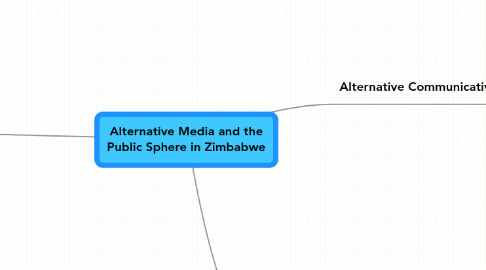
1. Zimbabwean Government
1.1. Control of written and public sphere
1.1.1. Alternative discourses
1.1.2. silenced
1.1.3. marginalized
1.1.4. isolated
1.2. Government influence
1.2.1. public opinion
1.2.1.1. main newspaper
1.2.1.2. radio station
1.3. Censorship of
1.3.1. Residents
1.3.2. Journalists
1.3.3. Artists
1.3.3.1. religious performances
1.3.4. Internet
1.3.4.1. Interception of Communications Bill
1.4. Legal Measures
1.4.1. Closure of independent newspapers
1.4.2. Central Intelligence Organization takeover of newspapers
1.5. Extralegal Measures
1.5.1. Arrests
1.5.2. Harrassment by Security Forces
2. Alternative Communicative Spaces
2.1. Not controlled by Zimbabwean Government
2.1.1. Platform for Prodemocracy Movements
2.1.2. Restrictive Communicative Space
2.1.2.1. Alternative explanations
2.1.2.2. political change
2.1.2.3. social change
2.2. Print
2.2.1. Independent Newspapers
2.3. Information and Communication Technologies
2.3.1. Internet
2.3.1.1. provide links to prodemocracy groups
2.3.1.2. SMS service to mobile phones
2.3.1.3. expand communicative space
2.3.1.3.1. counterpublic sphere
2.3.2. Radio
2.3.2.1. use of foreign transmission facilities
2.3.2.2. alternative news perspectives
2.4. Grassroots Communication
2.4.1. Art
2.4.2. Plays
2.4.3. Religious performances
2.4.4. Music
2.4.5. Video
2.4.6. Word of Mouth
3. Democratic Change
3.1. Sharing Information
3.1.1. Organized Citizen Involvement
3.1.1.1. Freedom of Speech
3.1.1.2. Hold current government accountable
3.1.1.3. Demand human rights
3.1.1.3.1. greater representation
